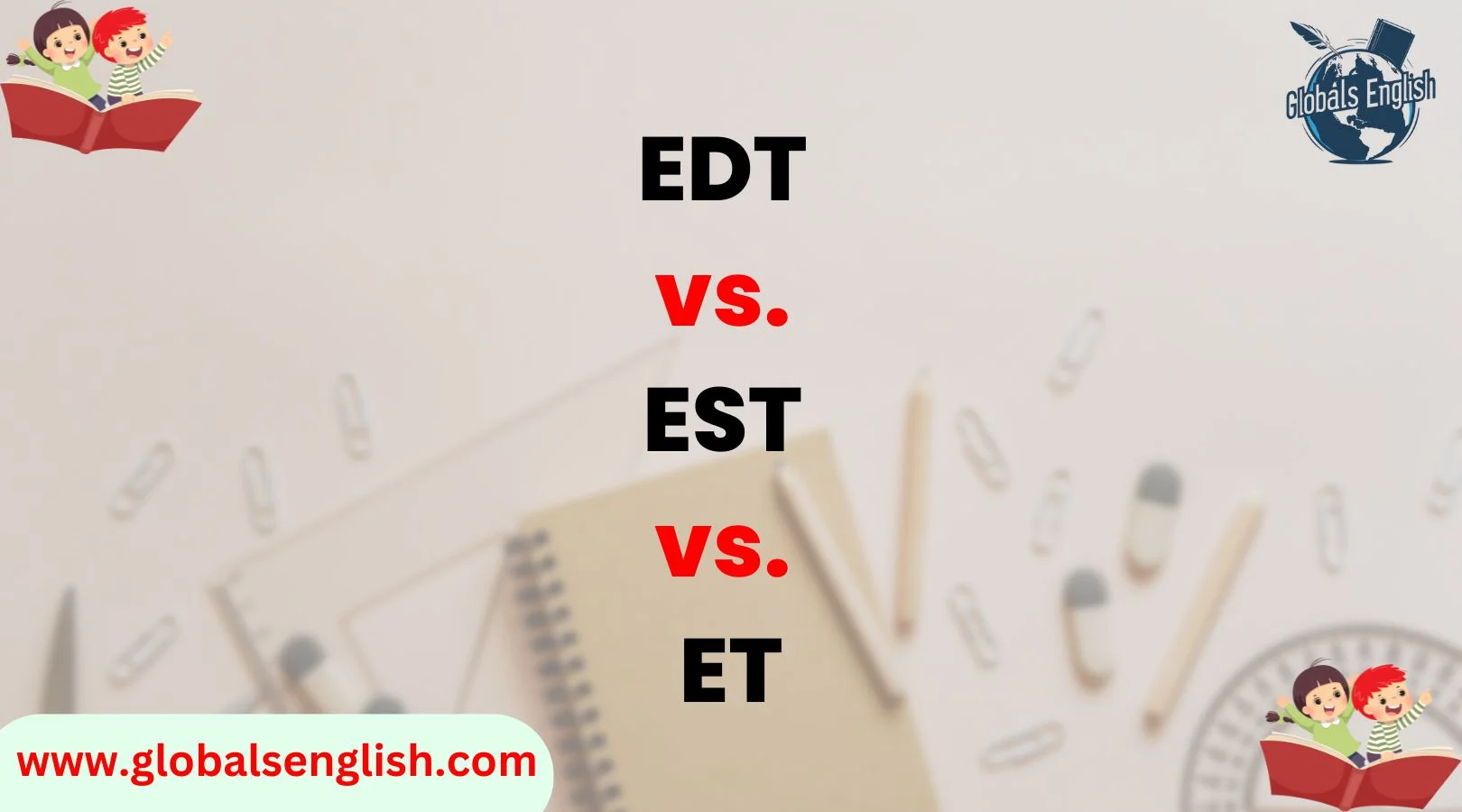Time zones might seem like a simple concept, but anyone who’s ever tried to schedule a meeting across the United States or make sense of international travel knows they can be tricky.
EDT, EST, and ET are terms that often cause confusion, especially when you’re dealing with busy schedules, global operations, or time-sensitive events.
In this article, we’ll explore the real differences between these time zones, when and how to use them, and why it’s crucial to understand their impact on everyday activities.
Understanding these time zones isn’t just about knowing what time it is in the Eastern part of the U.S.; it’s about applying that knowledge in real-world scenarios.
Whether you’re working with colleagues across different states, planning an event, or trying to make sense of a flight schedule, knowing the ins and outs of Eastern Time (ET) is essential.
But there’s a catch: these time zone abbreviations can be confusing, and even more so when considering Daylight Saving Time.
Let’s break down the differences, the terminology, and how it all fits into global timekeeping.
What Do EDT, EST, and ET Stand For?
To get started, let’s unpack these three common time zone terms that often get used interchangeably. While they’re all related to the Eastern Time Zone, there are key distinctions between them.
Understanding these abbreviations is essential before diving deeper into when each is used.
EDT (Eastern Daylight Time)
EDT stands for Eastern Daylight Time, which is the time used during the Daylight Saving Time (DST) period. The time zone shifts one hour forward from the standard Eastern Time, meaning the clocks are ahead by one hour compared to EST. EDT is typically used between the second Sunday in March and the first Sunday in November.
When Daylight Saving Time starts in the spring, people in the Eastern Time Zone “spring forward” an hour to account for more daylight during the longer summer days. For example, 8:00 AM EST becomes 9:00 AM EDT during this period.
EST (Eastern Standard Time)
EST, on the other hand, stands for Eastern Standard Time, which is the time used during the non-DST period. When Daylight Saving Time ends, the clocks “fall back” an hour, reverting to EST.
This typically happens from November to March. During this period, Eastern Time is five hours behind Coordinated Universal Time (UTC-5).
ET (Eastern Time)
ET is the general abbreviation for Eastern Time, and it refers to either EST or EDT, depending on the time of year. ET is a broader term and is often used when the specific distinction between EDT and EST is not important.
You’ll see ET used on many websites, schedules, or broadcasts to represent the general Eastern Time Zone, whether it’s in Daylight Saving Time or Standard Time.
The Difference Between EDT and EST
Although EDT and EST are both part of the Eastern Time Zone, the main difference between them lies in whether Daylight Saving Time (DST) is being observed. Let’s explore this in detail.
Daylight Saving Time vs. Standard Time
The key factor that differentiates EDT from EST is whether Daylight Saving Time is in effect. During Daylight Saving Time, the clocks are moved forward by one hour, giving more daylight in the evenings. This means that EDT is always one hour ahead of EST.
- EDT is observed in the spring and summer months when DST is active.
- EST is used in the fall and winter months when DST ends and regular Standard Time resumes.
It’s essential to note that not all regions within the Eastern Time Zone observe DST. For example, certain regions in the U.S. and Canada, including most of Arizona and Saskatchewan, do not observe DST and instead stay on Standard Time year-round.
Which One Should You Use?
When making plans or scheduling events, the rule is straightforward:
- Use EDT from March to November.
- Use EST from November to March.
If you’re ever unsure about whether it’s DST or Standard Time, checking the current date and the local time in the Eastern Time Zone should give you the answer.
What Does ET Mean?
So far, we’ve covered EDT and EST, but what about ET? Is it different, or is it the same?
Is ET the Same as EDT or EST?
The abbreviation ET stands for Eastern Time and is used as a catch-all term for both EDT and EST. It’s often used in contexts where it’s not necessary to specify whether Daylight Saving Time is being observed.
- ET could refer to either EDT or EST, depending on the time of year.
- For example, when you see a scheduled event listed as occurring at 7:00 PM ET, it’s important to check whether DST is being observed at that time.
When to Use ET Instead of EDT or EST
You’ll typically see ET used in more general contexts, like when companies, websites, or TV networks are scheduling events or broadcasting shows. It’s also commonly seen in news reports, business meetings, and other settings where precision isn’t as important as communicating the time zone in a simplified manner.
Does ET Change With the Seasons?
Yes, just like EDT and EST, ET shifts based on Daylight Saving Time. However, the key takeaway here is that ET doesn’t specify whether it’s EDT or EST—it’s an overarching term that applies to either one.
Where Is EDT and EST Used?
Regions That Follow Eastern Time
The Eastern Time Zone (ET) covers a vast area, both within the United States and internationally. Here’s a breakdown of the regions that use either EDT or EST.
- United States: The Eastern Time Zone includes states like New York, Florida, and Georgia, among others. States like Ohio and North Carolina also follow ET.
- Canada: Ontario, Quebec, and parts of Newfoundland and Labrador use ET.
- Caribbean: Countries like Jamaica, Haiti, and the Bahamas follow ET as well.
- South America: Countries like Colombia and Panama also observe Eastern Time.
While the U.S. and Canada use both EDT and EST, the Caribbean and South American regions typically follow only Standard Time, as they do not observe Daylight Saving Time.
Common Mistakes and Misconceptions About EDT, EST, and ET
Many people get confused when trying to work out time differences, especially across time zones. Here are some common mistakes and tips for avoiding them.
Confusion in Scheduling and Travel
One of the biggest problems people face is making time-related mistakes when scheduling events or booking flights. Confusing ET, EST, and EDT can lead to missed appointments or late arrivals. Always double-check the exact time zone of a meeting or event. For example, you could easily miss a conference call scheduled at 9:00 AM ET if you don’t realize that it’s in EDT and you’re planning to call in during EST.
Why International Travelers Must Double-Check
International travel can be especially tricky. If you’re flying from Los Angeles (PST) to New York (ET), make sure to check whether the time listed is in EST or EDT, as this could affect your flight timing. Adjusting for these small differences can save you stress.
How to Convert EDT, EST, and ET to Other Time Zones
Time Zone Conversions Made Simple
Converting between EDT, EST, and other time zones can be simplified with the right tools. Here are a few essential conversions:
| From | To | Time Difference |
| EDT | UTC | UTC – 4 hours |
| EST | UTC | UTC – 5 hours |
| ET | UTC | UTC – 5 hours (Standard) or UTC – 4 hours (Daylight) |
| EDT | PST | 3 hours behind |
| EST | PST | 3 hours behind |
Having a quick reference table handy or using online tools can save time when converting.
Daylight Saving Time: The Bigger Debate
Should We Get Rid of DST?
Many people question whether we should continue the practice of Daylight Saving Time. Some argue that it creates confusion, while others believe the extended daylight hours benefit businesses and social activities. Several U.S. states have even considered abolishing DST altogether.
In contrast, countries like European nations have opted to remain on one time year-round.
Frequently Asked Questions (FAQs)
What’s the difference between EDT and EST?
The primary difference between EDT (Eastern Daylight Time) and EST (Eastern Standard Time) is whether Daylight Saving Time (DST) is being observed. EDT is used during the summer months (from March to November) when clocks are set forward by one hour to make better use of daylight. EST is used during the winter months (from November to March) when clocks are set back to standard time.
Can I use ET for both EDT and EST?
Yes, ET (Eastern Time) is a general abbreviation that can refer to both EDT and EST, depending on the time of year. When you see ET, it typically means Eastern Time without specifying whether Daylight Saving Time is in effect.
When does Daylight Saving Time start and end?
Daylight Saving Time starts on the second Sunday in March and ends on the first Sunday in November. During this period, EDT is used in regions that observe Daylight Saving Time. The time shifts forward by one hour in the spring and shifts back by one hour in the fall.
Do all places in the Eastern Time Zone observe Daylight Saving Time?
No, not all regions within the Eastern Time Zone observe Daylight Saving Time. For example, parts of Arizona and Saskatchewan, Canada, stay on Standard Time year-round and do not observe DST.
What time zone should I use when booking a flight to New York?
When booking a flight to New York, always check the specific time of the flight and whether it’s listed as EDT or EST. New York is in the Eastern Time Zone, but during the summer months, it follows EDT, and during the winter months, it follows EST.
How do I convert EDT/EST to other time zones?
To convert EDT or EST to other time zones, use the following approximate conversions:
- EDT to UTC: UTC – 4 hours
- EST to UTC: UTC – 5 hours
- EDT to PST: EDT is 3 hours ahead of PST
- EST to PST: EST is 3 hours ahead of PST
Conclusion
Understanding the differences between EDT, EST, and ET is more than just academic—it has real implications for your work, travel, and daily life. Whether you’re scheduling meetings, traveling internationally, or setting your clocks for Daylight Saving Time, knowing when to use each term will help you avoid costly mistakes.
In summary, EDT and EST are time shifts within the Eastern Time Zone, with EDT used during Daylight Saving Time and EST during Standard Time. ET serves as a general term for both, depending on the time of year. By understanding these distinctions, you’ll be well-prepared to manage your time effectively in our interconnected world.

Emma Brooke is the author and creator behind Globals English, a platform dedicated to helping learners master the English language. With a passion for education and communication, Emma brings years of experience in language teaching and curriculum development. Her mission is to make English learning accessible, engaging, and effective for students worldwide.
